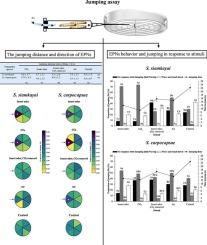Host-associated cues and their effects on the jumping behavior of Steinernema siamkayai
IF 3.4
2区 农林科学
Q2 BIOTECHNOLOGY & APPLIED MICROBIOLOGY
引用次数: 0
Abstract
Entomopathogenic nematodes are insect parasites with infective juveniles (IJs) employing host-seeking behaviors from ambush to cruise foraging. In ambush-foraging species, IJs often exhibit jumping behavior for attachment to host insects. Steinernema siamkayai, an ambush forager, exhibits both standing and jumping behaviors. However, the factors that enhance this behavior in S. siamkayai and how these factors differ among ambush foragers remain poorly understood. We investigated the influence of insect-associated cues on the jumping behavior of the Thai strain of S. siamkayai compared with S. carpocapsae. In the absence of stimuli, both species jumped 5.5 ± 1.9 mm and 3.8 ± 0.7 mm, respectively, with no observable effect of stimuli on jump distance. However, insect odors and CO2 triggered directional jumping toward the source, while the proportion of jumps toward insect odors decreased when CO2 was removed for both species. A higher percentage of S. siamkayai responded to insect odors by jumping compared with S. carpocapsae. Notably, air movement insignificantly affected S. siamkayai jumping, unlike in S. carpocapsae. An increase in stable standing behavior was observed in S. siamkayai populations when the absence of host cues. Furthermore, when stimulated by insect odors and CO2, S. siamkayai jumped twice as quickly as when stimulus was absent. These findings suggest that S. siamkayai is more sensitive to insect-related odors and behaves as an active ambush forager. This high responsiveness appears to be a key behavioral trait for infecting insect pests that actively move near the soil surface in tropical regions.

寄主相关线索及其对海蛾跳跃行为的影响
昆虫病原线虫是一种具有感染性幼虫的昆虫寄生虫,具有从伏击到巡航觅食的寻宿主行为。在伏击觅食的物种中,ij经常表现出跳跃行为,以依附于宿主昆虫。Steinernema siamkayai是一种伏击觅食动物,表现出站立和跳跃的行为。然而,在s.s siamkayai中增强这种行为的因素以及这些因素在伏击觅食者之间的差异仍然知之甚少。研究了昆虫相关线索对泰国菌株siamkayai和S. carpocapsae跳跃行为的影响。在没有刺激的情况下,两个物种的跳跃距离分别为5.5±1.9 mm和3.8±0.7 mm,没有观察到刺激对跳跃距离的影响。然而,昆虫气味和二氧化碳触发了向源的定向跳跃,而当去除二氧化碳时,两种物种向昆虫气味的跳跃比例下降。对昆虫气味的反应中,有较高比例的siamkayai比carpocapsae跳高。值得注意的是,与S. carpocapsae不同,空气运动对S. siamkayai的跳跃影响不显著。在没有宿主提示的情况下,观察到siamkayai种群中稳定站立行为的增加。此外,当受到昆虫气味和二氧化碳的刺激时,S. siamkayai的跳跃速度是没有刺激时的两倍。这些发现表明,S. siamkayai对昆虫相关的气味更敏感,并且表现为活跃的伏击觅食者。这种高反应性似乎是感染热带地区主动靠近土壤表面移动的害虫的关键行为特征。
本文章由计算机程序翻译,如有差异,请以英文原文为准。
求助全文
约1分钟内获得全文
求助全文
来源期刊

Biological Control
生物-昆虫学
CiteScore
7.40
自引率
7.10%
发文量
220
审稿时长
63 days
期刊介绍:
Biological control is an environmentally sound and effective means of reducing or mitigating pests and pest effects through the use of natural enemies. The aim of Biological Control is to promote this science and technology through publication of original research articles and reviews of research and theory. The journal devotes a section to reports on biotechnologies dealing with the elucidation and use of genes or gene products for the enhancement of biological control agents.
The journal encompasses biological control of viral, microbial, nematode, insect, mite, weed, and vertebrate pests in agriculture, aquatic, forest, natural resource, stored product, and urban environments. Biological control of arthropod pests of human and domestic animals is also included. Ecological, molecular, and biotechnological approaches to the understanding of biological control are welcome.
 求助内容:
求助内容: 应助结果提醒方式:
应助结果提醒方式:


